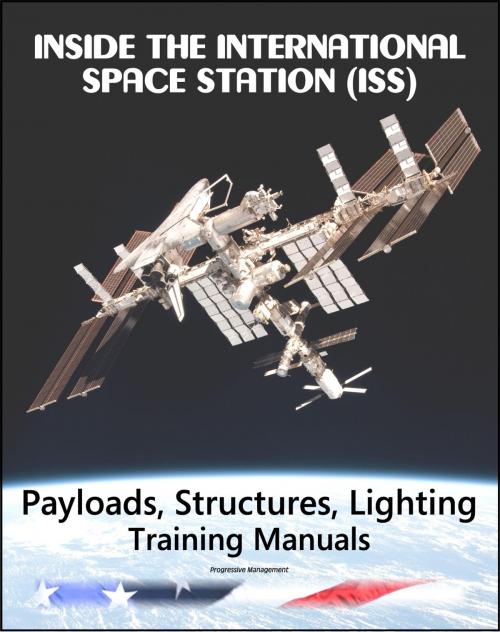Inside the International Space Station (ISS): NASA Payloads, Operations, and Interfaces, Structures and Mechanisms, and Lighting Astronaut Training Manuals
Nonfiction, Science & Nature, Science, Physics, Astronomy| Author: | Progressive Management | ISBN: | 9781466164383 |
| Publisher: | Progressive Management | Publication: | December 18, 2011 |
| Imprint: | Smashwords Edition | Language: | English |
| Author: | Progressive Management |
| ISBN: | 9781466164383 |
| Publisher: | Progressive Management |
| Publication: | December 18, 2011 |
| Imprint: | Smashwords Edition |
| Language: | English |
Learn about the International Space Station (ISS) from the textbooks used by the astronauts! These astronaut and flight controller training manuals, produced by the Mission Operations Directorate (Space Flight Training Division branch) at NASA's Johnson Space Center, represent a major part of the formal flight crew training process. The manuals and workbooks are extremely detailed and comprehensive, and are designed for self-study. A full listing of all acronyms and abbreviations used in the text is included. They provide a superb way to learn about Station systems, hardware, and operational procedures. Special emphasis on crew interaction with the displays, controls, and hardware is included.
These three training manuals cover the ISS payloads, structures, and lighting systems. The first manual provides an overview of the Payload Operations and Interfaces concept for the International Space Station (ISS). The material presented focuses on critical elements of realtime ISS payload operations, including ground operations, interfaces between U.S. and International Partner (IP) payload operations centers, ground support interaction, and payload logistics. ISS standard payload hardware and payload-related support systems are also discussed. The manual was developed for individuals possessing an understanding of the basic principles of manned space flight operations. After completing this section, the student should be able to: Describe the standard ISS systems interfaces for the International Standard Payload Rack (ISPR), EXpedite the PRocessing of Experiments to the Space Station (EXPRESS) Rack and EXPRESS Pallet; Describe the crew/ground common payload operations; Identify the unique payload operations associated with EXPRESS, and Attached Payloads; Identify major roles and interfaces of ISS Payload Operations and Ground Networks; Describe system-specific interfaces between payload hardware and Station resources.
Structures protect the crew from the environment of space. Structures transfer loads and provide support for the various systems. Loads are the mechanical, pressure, vibration, inertial, and thermal forces applied to structural elements. The structures on ISS are made with aluminum alloys which have been used extensively for ISS because they are lightweight, corrosion resistant, and have favorable electrical conductivity which aids in grounding electrical systems. There are two main types of structures on ISS: pressurized elements and truss assemblies.
The lighting system provides illumination for the interior and exterior of the International Space Station (ISS). The internal lighting varies throughout the different modules, nodes, and airlock, but all function to provide illumination for displays, controls, crew station, and crew equipment operations. The exterior lighting provides illumination for Extravehicular Activity (EVA) and video camera operations. This manual covers the different types of lighting provided in the United States (U.S.) modules and the exterior lighting, as well as how the lighting equipment is powered and controlled.
Learn about the International Space Station (ISS) from the textbooks used by the astronauts! These astronaut and flight controller training manuals, produced by the Mission Operations Directorate (Space Flight Training Division branch) at NASA's Johnson Space Center, represent a major part of the formal flight crew training process. The manuals and workbooks are extremely detailed and comprehensive, and are designed for self-study. A full listing of all acronyms and abbreviations used in the text is included. They provide a superb way to learn about Station systems, hardware, and operational procedures. Special emphasis on crew interaction with the displays, controls, and hardware is included.
These three training manuals cover the ISS payloads, structures, and lighting systems. The first manual provides an overview of the Payload Operations and Interfaces concept for the International Space Station (ISS). The material presented focuses on critical elements of realtime ISS payload operations, including ground operations, interfaces between U.S. and International Partner (IP) payload operations centers, ground support interaction, and payload logistics. ISS standard payload hardware and payload-related support systems are also discussed. The manual was developed for individuals possessing an understanding of the basic principles of manned space flight operations. After completing this section, the student should be able to: Describe the standard ISS systems interfaces for the International Standard Payload Rack (ISPR), EXpedite the PRocessing of Experiments to the Space Station (EXPRESS) Rack and EXPRESS Pallet; Describe the crew/ground common payload operations; Identify the unique payload operations associated with EXPRESS, and Attached Payloads; Identify major roles and interfaces of ISS Payload Operations and Ground Networks; Describe system-specific interfaces between payload hardware and Station resources.
Structures protect the crew from the environment of space. Structures transfer loads and provide support for the various systems. Loads are the mechanical, pressure, vibration, inertial, and thermal forces applied to structural elements. The structures on ISS are made with aluminum alloys which have been used extensively for ISS because they are lightweight, corrosion resistant, and have favorable electrical conductivity which aids in grounding electrical systems. There are two main types of structures on ISS: pressurized elements and truss assemblies.
The lighting system provides illumination for the interior and exterior of the International Space Station (ISS). The internal lighting varies throughout the different modules, nodes, and airlock, but all function to provide illumination for displays, controls, crew station, and crew equipment operations. The exterior lighting provides illumination for Extravehicular Activity (EVA) and video camera operations. This manual covers the different types of lighting provided in the United States (U.S.) modules and the exterior lighting, as well as how the lighting equipment is powered and controlled.















